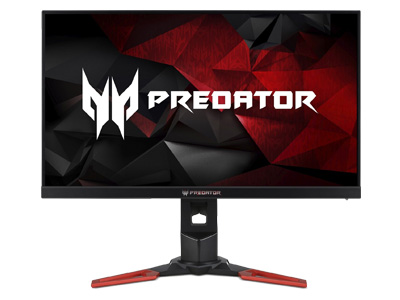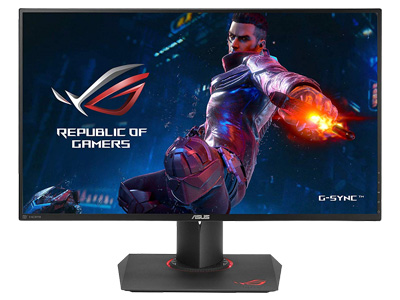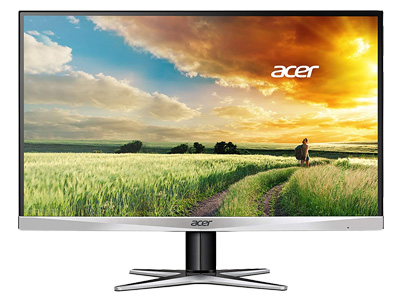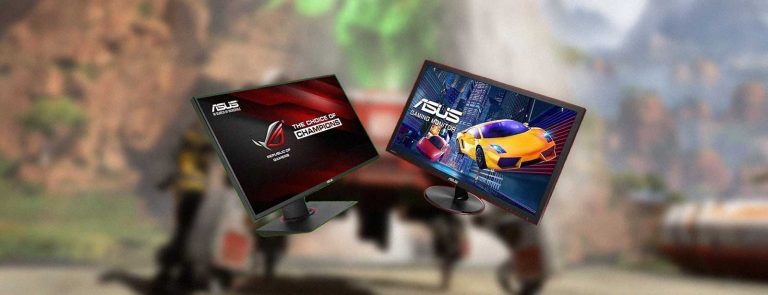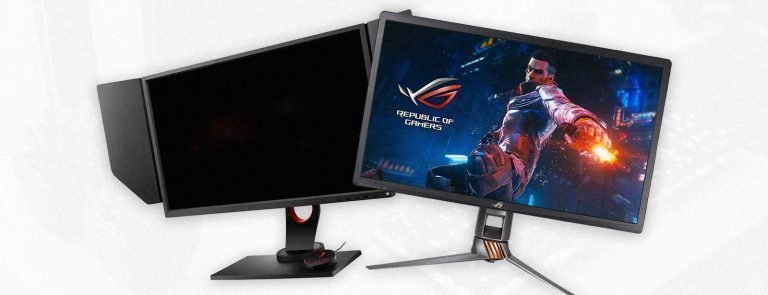Choosing a 1440p gaming monitor can be an issue due to the fact that there are plenty of monitors out there that offer higher resolution. But are they suitable for gaming?
If you have confused regarding which 1440p monitor is the most suitable for you, then you need not worry. Here we have are going to review some of the best 1440p gaming monitors available on the market today.
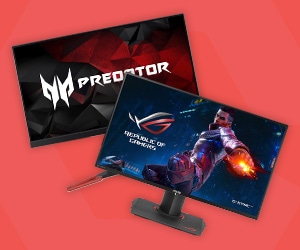
Before we get into that, here are a comparison of all the monitors we’re going to checkout. So you don’t have to when you are in the market for a new 1440p display.
Premium Pick
- 27" Display with Thin Bezels
- 165Hz Refresh Rate
- IPS Panel with Vibrant Colors
Table of Contents
Top Rated 1440p Monitors For Gaming Comparison Table
The following are the 1440p gaming monitors that we are going to look into and some specifications that you might be interested in:
| Monitor Name | Refresh Rate | Response Time | |
|---|---|---|---|
| Acer Predator XB271HU | 144 Hz | 4 ms | Check Price |
| ASUS ROG SWIFT PG279Q | 165 Hz | 5 ms | Check Price |
| Acer G257HU | 60 Hz | 4 ms | Check Price |
| ASUS PB278Q | 60 Hz | 4.8 ms | Check Price |
| Dell S2719DGF | 144 Hz | 1 ms | Check Price |
| AOC Q2778VQE | 60 Hz | 5ms | Check Price |
| BenQ ZOWIE XL2740 | 144 Hz | 1 ms | Check Price |
| Acer Curved XR341CK | 144 Hz | 4 ms | Check Price |
| VIOTEK GN27D | GN27D | 4.8 ms | Check Price |
| Samsung C32HG70 QLED | 144 Hz | 1ms | Check Price |
The Best 1440p Gaming Monitors in 2020
1. Acer Predator XB271HU – Best 1440p Gaming Monitor
The Acer Predator XB271HU has a slim design, which is something that all gamers can appreciate. The 27-inch display has a 16:9 aspect ratio. It comes with Nvidia G-Sync technology which reduces screen tearing.
The Acer Predator XB271HU offers plenty of features that you do not get on your average monitor. If you are willing to pay a premium for a better gaming experience then you should consider getting this display.
Key features:
- This monitor has a 144 Hz refresh rate. However, the refresh rate can be overclocked to 165Hz by using a display port which enhances a smooth gaming experience even further.
- Has Flicker-less technology included that reduces annoying screen flickering, keeping your eyes protected.
- The IPS panel in this gaming monitor enhance the color accuracy from different viewing angles, and with a great response time of 4ms, you will ultimately get immersed in the gaming world.
Pros
- Gorgeous Design
- 144Hz refresh rate
- Nvidia G-Synch Technology
- 4ms response time
- IPS panel
Cons
- Expensive
2. ASUS ROG SWIFT PG279Q – Premium 1440p Gaming Monitor
ASUS ROG Swift PG279Q monitor has been designed for gamers and that’s pretty obvious once you have had a good look at it. The 27’’ display has very thin bezels which are great for immersion.
ASUS eye care technology offers a TUV certified flicker-free screen combined with a blue filter for reducing eye fatigue. The display offers a 165 Hz refresh rate which means that you will get a much smoother experience when playing games.
The ASUS ROG gaming monitor has got plenty of features which is something that you expect from ASUS. If you are willing to pay a premium for these additional features then this is a great gaming monitor for you.
This is an IPS panel so you will get the deep black and vibrant colors. The monitor also comes with Nvidia G-Sync technology which reduces screen tearing.
Key Features:
- This 1440p gaming monitor has got a sizeable 27-inch size display with a thin bezel design. A great balance of screen size and resolution for an excellent gaming experience.
- ASUS gaming monitors come with eye care technology. This tech offers a TUV certified flicker-free screen combined with a blue filter for less eye fatigue.
- Got an IPS panel for immersive bright colors with a reasonable response rate.
Pros
- Ergonomic design.
- Nvidia G-Sync
- 165Hz refresh rate
- IPS panel.
- Asus Eye Care
Cons
- Pricey
3. Acer G257HU – Budget 1440p Gaming Monitor
The Acer G257HU is one of the most immeasurable 1440p monitors available on the market right now. It has a slim and sleek design. The 25″ display has a resolution of 2560×1440 and runs at 60 Hz. For input, you have DVI and HDMI ports. The display offers 4ms response time. The display also has a low power consumption feature.
The Acer G257HU is one of the best gaming monitors. The price is pretty reasonable keeping in mind that you are getting a very slim display that is not only functional but also looks good. If that is something that you want then you should order one now.
Key features:
- This monitor has got a stunning 25″ display with a 2560×1440 resolution.
- Comes with good compatibility options as well. Both DVI and HDMI input, you can easily power it up with a console or any other compatible device.
- Got a 60 Hz refresh rate.
- The rapid 4 ms response time reduces deviation in transition time so that it can deliver quality moving images.
Pros
- Widescreen gaming monitor
- 60 Hz refresh rate
- HDMI and DVI input
- Slim design
- 4ms rapid response time
Cons
- The stand is terrible
4. ASUS PB278Q
The ASUS PB278Q a budget 1440p gaming monitor which is very popular amongst gamers. The 27-inch display has got a 16:9 aspect ratio with 100% sRGB colors and a 178° wide viewing angle.
ASUS eye care technology offers a TUV certified flicker-free screen combined with a blue filter for reducing eye fatigue. For input, you have DVI and HDMI ports.
Key features:
- Various connectivity options with the inclusion of display port, HDMI port, and a dual-link DVI port as well.
- Video intelligence technology with an exclusive ASUS QuickFit gives more life-like visuals as compared to other monitors.
- There are two stereo speakers available on each side of the monitor, respectively. However, they are not much of use due to its lousy speaker quality.
Pros
- Affordable price
- 60Hz Refresh rate
- Ergonomic design.
- IPS panel
- Eye-care technology
- Flicker-free screen
Cons
- Nvidia G-Synch not available
- Blacklight bleeding issues
5. Dell S2719DGF
Dell has introduced the brand-new Gaming S2716DGR monitor. The 26-inch display has a 16:9 aspect ratio and comes with Nvidia G-Sync technology. The 144 Hz refresh rate ensures a smooth gaming experience.
The only downside is that the monitor uses a TN panel rather than an IPS panel.
Key features:
- Has an adjustable stand that can be adjusted according to the needs.
Pros
- Ergonomic design
- 144 Hz refresh rate
- Fast response time
- Nvidia G-Sync Technology
Cons
- TN display panel
- Dropped signal inputs
6. AOC Q2778VQE
The AOC Q2778VQE is very popular in the gaming space because it’s so cheap. The display comes with a 2mm ultra-narrow bezel design. This is an IPS panel so you will get those deep blacks and vibrant colors
The monitor has a non-reflective anti-glare coating this will keep light reflections to a minimum. It has a 5ms response time which is a bit higher than other monitors on this list but is still respectable.
Key features:
- Has VGA and DVI-D ports making this monitor compatible with many devices.
Pros
- 2mm ultra-narrow bezels
- IPS panel
- 60 Hz refresh rate
- Inexpensive
- Multi-purpose detachable stand
Cons
- A bit wobbly
7. BenQ ZOWIE XL2740
If you want an eSports gaming monitor at your home for a perfect gaming experience then BenQ Zowie is an ideal option.
The monitor has a 144Hz refresh rate with a response time of only 1ms.
The 27-inch QHD 2560×1440 display has an ergonomic design that lets you adjust the height according to your preference.
Key features:
- The gaming monitor is adopted worldwide and is used widely for different eSports tournaments of different FPS games like CS:GO. It is also used for other gaming events.
- The gaming monitor also comes with an S switch, enables you to switch between custom display profiles with a single button click.
Pros
- 1ms response time
- Esports gaming monitor
- 144 Hz refresh rate
- Low Power consumption option
- Blue light filter
- Flicker-free technology
Cons
- Costly
- The contrast ratio is average
8. Acer Curved XR341CK
When we talk about the gaming monitors with a curved display, the first monitor that pops up in our head is the brand-new Acer XR341CK. This 34″ curved display has a 21:9 aspect ratio and 3440×1440 resolution.
The monitor comes with ambient lighting that can be customized. The display also has two powerful 7W speakers. This is an IPS panel so you get better colors and deep blacks.
Key features:
- Has a 75Hz refresh rate, which is above the bare minimum of 60hz for gaming in our opinion.
Pros
- Curved LED display
- 21:9 aspect ratio
- Ergonomic design
- Ambient lighting
- IPS panel
- Two built-in speakers
Cons
- A bit pricey
9. VIOTEK GN27DB
Out of the box, you get a 144Hz refreshing rate and a fast response of only 4.8ms. The resolution of the display is 2560×1440 with almost 16.7 million colors.
Key features:
- The anti-glare screen and low blue light setting keep the eye away from fatigue and strain.
Pros
- Relatively affordable price
- 1800R curve
- 144hz refresh rate
- 16.7 million colors
- FreeSync Technology
Cons
- Not an IPS Panel
- The design is not ergonomic
10. Samsung C32HG70 QLED
The last 1440p monitor on our list is the Samsung QLED monitor which has got the attention of many gamers because of its sleek design and specifications.
The monitor comes with quantum dot technology which ensures vigorous and bright colors. This technology is exclusive to Samsung and you won’t be able to get it anywhere else.
The display supports 1 billion colors and has a resolution of 2560×1440. The refresh rate is 144 Hz and the response time is only 1ms.
Key features:
- With an ergonomic design, you can adjust the position of a monitor as it has got an adjustable stand.
Pros
- Quantum Dot Technology
- 1 billion colors supported
- 144 Hz refresh rate
- 1ms response time
- Ergonomic Design
Cons
- Pricey
Is a 1440p Gaming Monitor Worth it?

As 1440p displays are becoming cheaper and graphics cards are becoming more powerful, this is slowly becoming the new standard, at least for mid-range gamers. Modern graphics cards like the GTX 1050 Ti are perfectly capable of running games at decent settings at 1080p.
Mid-range gamers that are interested in getting cards like the AMD RX 580 and the GTX 1070 have the option to run games at 1440p.
I would like to point out that this is not something that you can experience through a YouTube video. You need to see the difference in person to see what I am talking about.
Things to Consider before Buying a 1440p Monitor
There are certain factors that you need to keep in mind when you are in the market for a new 1440p display.
System Requirement
Please check your system requirements before you make you buy a 1440p monitor. To play any game on a 1440p monitor you need certain hardware. The minimum and recommended pc requirements are as follows:
Minimum Requirements
To play games at 1440p 60 Hz, you will need an Nvidia GTX 980 or AMD R9 390X. You will also need a fairly decent CPU that can keep up with your graphics card.
Maximum Settings
If you want to play games at maximum settings on a 1440p monitor with a refresh rate of 120 Hz, you will need a powerful graphics card. Nvidia graphics cards like GTX 980 Ti, GTX 1070 and GTX 1080 are decent options. You can also go with the AMD Vega series.
TN vs IPS Panel
There are two types of panels that modern monitors use. TN (Twisted Nematic) and IPS (in-plane switching). TN panels support a faster response rate but the color quality is not so good. TN panels offer narrow viewing angles as well.
An IPS panel is capable of reproducing color with much more accuracy than a TN panel. It offers wider viewing angles but it only supports a response time of up to 4ms.
What to Look For in a 1440p Gaming Monitor
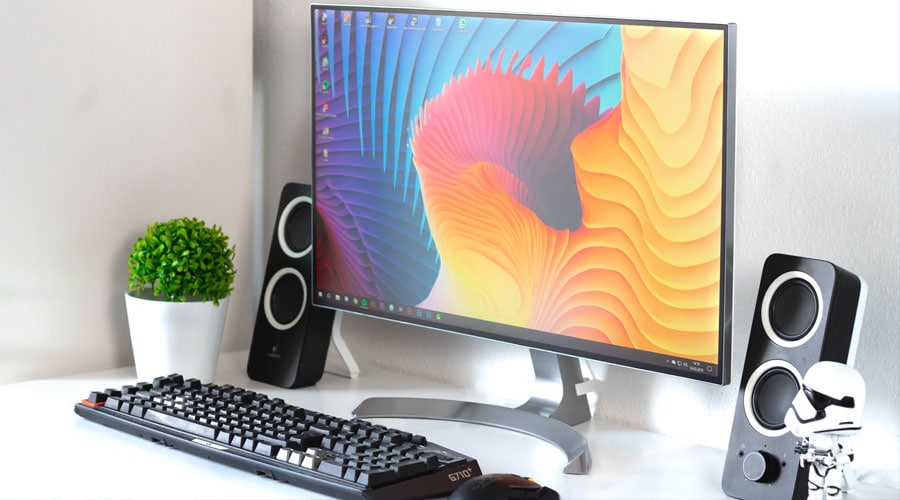
There are plenty of gaming monitors out there and you might be confused regarding which one you should get. If you are getting your first 1440p monitor then there are some things that you might not know. If that is indeed the case then you have come to the right place. Here we are going to cover some of the essential things that you need to know when in the market for a new 1440p display.
Resolution
There are three types of resolutions widely available for most gaming monitors. Here we are going to look into each one.
1080 Full HD
This is a standard resolution also known as 1920×1280 pixels. Monitors with this resolution are usually inexpensive.
1440p QHD or 2K
1440p monitors are getting cheaper and this is now becoming the new sweet spot for gaming. 1440p monitors have a resolution of 2560×1440 pixels. This higher resolution offers higher graphical fidelity as compared to 1080p.
2160p UHD or 4K
2160p also known as 4K gaming monitors are the most expensive gaming monitors and you need some serious hardware to run games at such a high resolution.
Refresh Rate
The refresh rate of a gaming monitor is measured in Hertz. Refresh rate refers that how many times a monitor can refresh the displayed image in one second. There are four types of gaming monitors with respect to refresh rate:
- 60 Hz
- 120 Hz
- 144 Hz
- 240 Hz
60 Hz gaming monitors are the most common ones. If you want a smoother gaming experience and have the hardware to back that up then you can opt to go with a monitor that has a higher refresh rate.
Adaptive-Sync
To avoid screen tearing issues graphics cards manufacturers have introduced dedicated solutions. AMD offers Free-Sync technology and Nvidia has G-Sync.
Remember that you will need a graphics card from the respective brand in order to take advantage of these features. It is also worth noting that G-Sync monitors are more expensive as compared to the ones that come with Free-Sync.
Response Time
The response time of a gaming monitor is measured in milliseconds. Response time refers to the time a single pixel takes to switch from black to white or different shades of gray.
Why is it important?
Conclusion
We have tried to give our best in explaining the 1440p gaming monitors and now it is your choice to make a decision of buying the perfect one according to your demands.
GamingFeature invests hundreds of hours of research and testing to help our readers in finding products that fit their specific needs. You support us through our independently chosen links, which earn us a commission. Read more about what we do.
